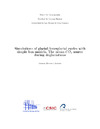Identificador persistente para citar o vincular este elemento:
https://accedacris.ulpgc.es/jspui/handle/10553/10698
| Campo DC | Valor | idioma |
|---|---|---|
| dc.contributor.advisor | García-Olivares Rodríguez, Antonio | - |
| dc.contributor.author | Herrero Navarro, Carmen | - |
| dc.date.accessioned | 2013-09-11T05:00:10Z | - |
| dc.date.accessioned | 2018-05-15T10:47:31Z | - |
| dc.date.available | 2013-09-11T05:00:10Z | - |
| dc.date.available | 2018-05-15T10:47:31Z | - |
| dc.date.issued | 2012 | en_US |
| dc.identifier.uri | https://accedacris.ulpgc.es/handle/10553/10698 | - |
| dc.description.abstract | Paillard and Parrenin [2004] model has been modified to obtain a closer fit to 18O and CO2 time-series for the last 800 kyr. Some sub-models have been developed, finding an improvement in performance if CO2 sensitivity to I65 insolation is eliminated, and if different response times are assumed for both absorption/emission of CO2 and for ablation/ accumulation of ice. Correlations between simulated and experimental time-series have increased from 0.64 and 0.61 (for ice volume and CO2) to 0.89 and 0.81, respectively. It has been found that the model is almost insensitive to late Austral summer insolation (60°S, 21st February) which leads to some conceptual changes, characterized in the Local Model with Double Stratification (LMDS). In LMDS, local proxies for Antarctic temperature have been used and stratification has been described to operate in two different ways: locally via the extent of Antarctic ice sheet and local temperature; and globally through global ice volume, V (which is strongly correlated to temperature changes in Northern Hemisphere), making a interconnection between oceanic pulse of CO2 in Southern Ocean (SO) and Northern Hemisphere (NH). According to this model, terminations are produced by I65 amplification, through CO2- T and T -CO2 feedback, in synergy with an extra CO2 contribution coming from the deep ocean. This CO2 pulse may be controlled by variations in the deep water formation rate in the Antarctic shelf, which is strongly dependent on ice volume and sea ice extent, being thus consistent with either a teleconnection mechanism via North Atlantic Deep Water upwelled in the SO (mechanism suggested by Gildor and Tziperman [2001]), or with sea-ice extent controlled by a local temperature (as suggested by Paillard and Parrenin [2004]). | es |
| dc.format | application/pdf | es |
| dc.language | eng | en_US |
| dc.rights | by-nc-nd | es |
| dc.subject | 2510 Oceanografía | es |
| dc.title | Simulations of glacial/interglacial cycles with simple box-models. The ocean CO2 source during deglaciations | en_US |
| dc.type | info:eu-repo/semantics/masterThesis | en_US |
| dc.type | MasterThesis | en_US |
| dc.compliance.driver | 1 | es |
| dc.contributor.facultad | Facultad de Ciencias del Mar | en_US |
| dc.identifier.absysnet | 687037 | es |
| dc.identifier.crisid | - | - |
| dc.investigacion | Ciencias | es |
| dc.rights.accessrights | info:eu-repo/semantics/openAccess | es |
| dc.type2 | Trabajo final de máster | en_US |
| dc.identifier.matricula | TFT-30508 | es |
| dc.identifier.ulpgc | Sí | es |
| dc.contributor.titulacion | Máster Universitario en Oceanografía | es |
| item.grantfulltext | open | - |
| item.fulltext | Con texto completo | - |
| Colección: | Trabajo final de máster | |
Visitas
62
actualizado el 27-jul-2024
Descargas
103
actualizado el 27-jul-2024
Google ScholarTM
Verifica
Comparte
Exporta metadatos
Los elementos en ULPGC accedaCRIS están protegidos por derechos de autor con todos los derechos reservados, a menos que se indique lo contrario.
